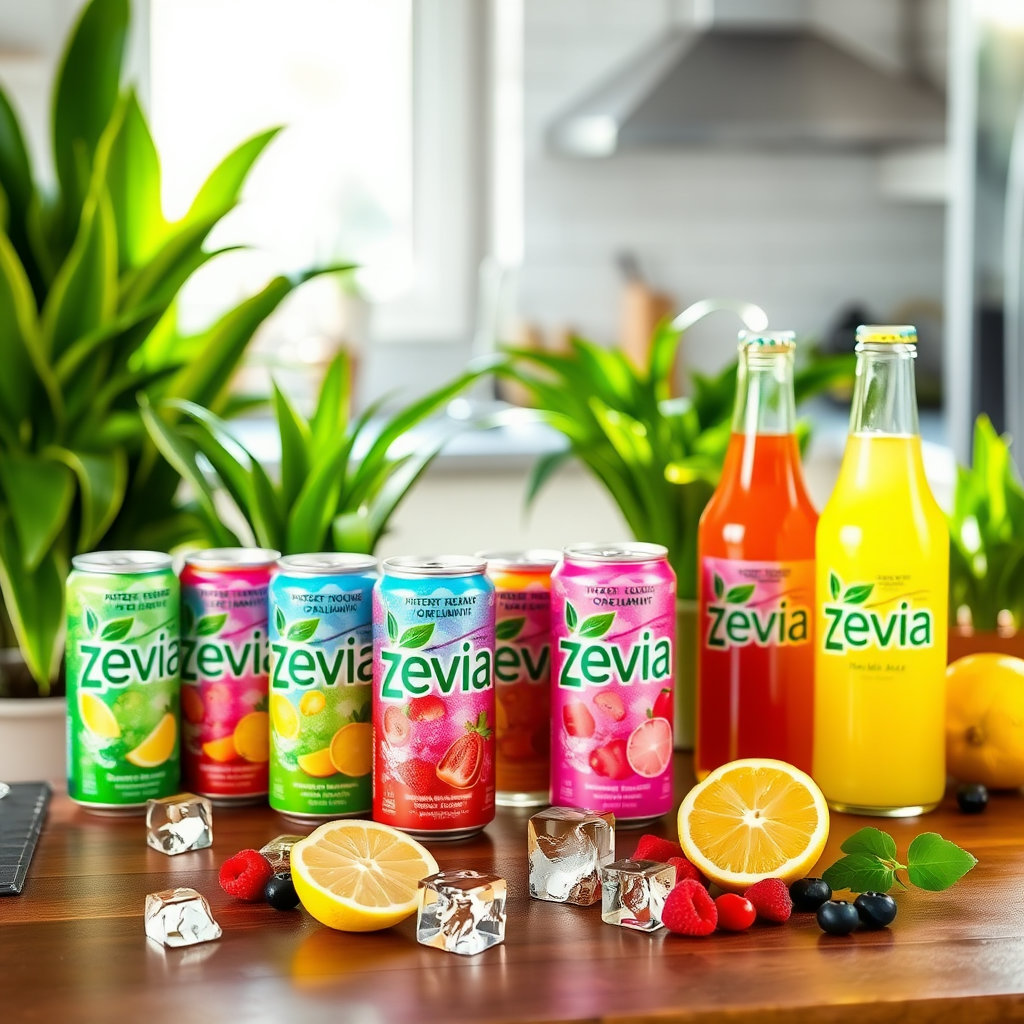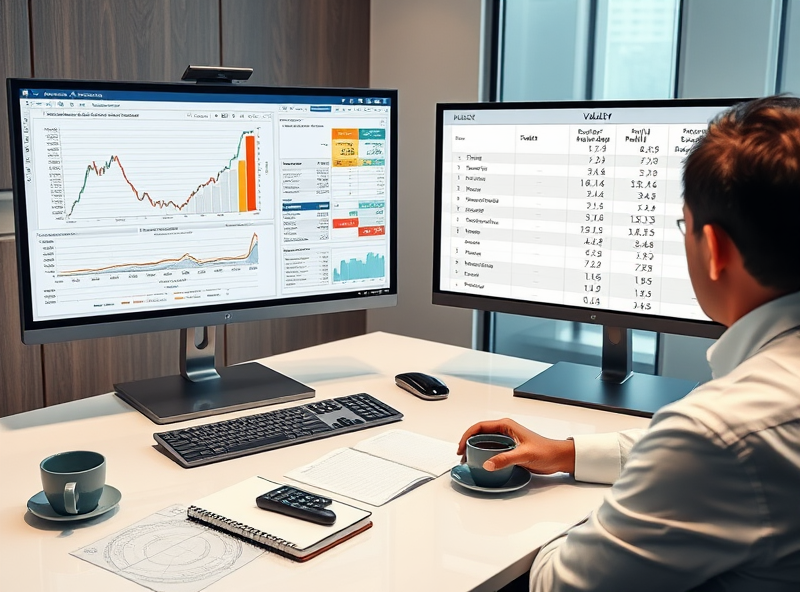Zevia Stock Analysis: Key Metrics and Investment Strategies
Hey there, lovely people! Let’s chat about something interesting in the stock market today: Zevia PBC (NYSE: ZVIA). You know, the company that’s trying to make our drink choices a little bit healthier? It’s always fascinating to look at companies that are trying to carve out their own space by offering something different, isn’t it? Zevia is definitely doing that in the beverage world.
They’re not just making drinks; they’re building a brand around zero sugar, natural sweetness (thanks to stevia!), and a commitment to being better for us and the planet (hello, B Corp certification!). They’ve got a whole lineup – sodas, energy drinks, teas, mixers – all designed for folks who want delicious flavor without the sugar crash or artificial stuff. It feels good to see companies thinking about health and sustainability, right?
Let’s dive a little deeper into what’s been happening with Zevia and what it might mean if you’re thinking about investing.
Understanding Zevia: More Than Just a Drink
Before we get into the numbers, it’s good to know what Zevia is all about. Their core mission is to provide zero-sugar, naturally sweetened beverages that taste great. They use stevia leaf extract as their primary sweetener, avoiding artificial sweeteners and high-fructose corn syrup that are common in many traditional drinks. This focus aligns perfectly with the growing consumer trend towards healthier lifestyles and reduced sugar intake.
Their product portfolio is quite diverse, covering several categories within the beverage market. This includes their core soda line, but also extends to energy drinks, organic teas, and sparkling water. This diversification helps them reach different consumer segments and occasions. For instance, someone looking for a morning energy boost might grab a Zevia Energy, while someone else might want a refreshing Zevia Soda with dinner.
Being a certified B Corp is also a significant part of their identity. This certification means they meet high standards of verified performance, accountability, and transparency on factors from employee benefits and charitable giving to supply chain practices and input materials. For many consumers and investors today, these environmental, social, and governance (ESG) factors are becoming increasingly important. It shows a commitment beyond just making a profit.
So, when we look at Zevia, we’re not just analyzing a beverage company; we’re looking at a company trying to lead with a specific set of values and cater to a health-conscious, environmentally aware consumer base. This positioning is their strength, but it also comes with its own set of challenges, as we’ll see.
Recent Performance Snapshot: A Look at Q1 2025
Let’s talk about how Zevia has been doing lately, specifically looking at their first quarter results for 2025. Earnings reports are always a big moment for any company, giving us a peek under the hood.
Zevia’s Q1 2025 report had some notable points. On the positive side, they achieved record gross margins. This is genuinely good news! Gross margin is essentially the revenue left after deducting the cost of goods sold. A higher gross margin means the company is becoming more efficient at producing its products – perhaps they’re getting better deals on ingredients, optimizing their production process, or managing their supply chain more effectively. This indicates operational improvement, which is a key factor for long-term profitability.
However, the report also showed that they missed revenue expectations. This means the total sales figure for the quarter wasn’t as high as financial analysts had predicted. There could be many reasons for this – maybe sales growth slowed down a bit, or perhaps distribution challenges impacted their ability to get products onto shelves. Missing revenue targets can sometimes worry investors, as it might suggest slower-than-expected market penetration or demand.
Interestingly, despite the revenue miss, the stock price saw a positive reaction in after-hours trading, climbing by 8.87% to USD 2.21. This kind of market reaction can seem counterintuitive. Why would a stock go up when revenue expectations weren’t met? Sometimes, investors might have been bracing for worse news, or they might be placing more emphasis on the positive aspects, like those strong gross margins, seeing them as a sign of future potential. It could also be influenced by broader market sentiment or specific analyst commentary following the report. It just goes to show that stock prices don’t always move in the way you might initially expect based on one piece of data.
This mixed performance in Q1 2025 highlights that Zevia is a company with both promising operational improvements and ongoing challenges in scaling its top-line growth.
Key Financial Metrics: Digging into the Numbers
To get a better sense of Zevia’s financial health, let’s look at some key metrics. These numbers give us a more objective view of the company’s performance beyond just the headlines of an earnings report.
One important metric is the Profit Margin. Zevia currently has a negative profit margin of -12.58%. This means that for every dollar of sales, the company is losing about 12.58 cents after accounting for all expenses, including production costs, operating expenses, interest, and taxes. A negative profit margin indicates that the company is not currently profitable. For a young, growing company, this isn’t necessarily a death knell, as they might be investing heavily in expansion, marketing, and infrastructure. However, sustained negative margins are a concern for investors looking for profitability.
Next, let’s look at Return on Assets (ROA) and Return on Equity (ROE). Zevia’s ROA (ttm) is -15.71%, and its ROE (ttm) is -49.17%. ROA measures how efficiently a company uses its assets to generate profit, while ROE measures how much profit a company generates with the money shareholders have invested. Negative figures for both indicate that the company is not effectively using its assets or shareholder funds to create positive returns. This aligns with the negative profit margin – if the company isn’t profitable, these return metrics will also be negative. These are crucial metrics for assessing management’s efficiency and the company’s ability to generate value from its resources.
Their Trailing Twelve-Month (ttm) Revenue is USD 154.27 million. This figure represents the total sales revenue over the past year. While the Q1 revenue missed expectations, the overall ttm revenue gives a sense of their scale. USD 154.27 million is a significant amount, showing they have a presence in the market, but it’s still relatively small compared to the giants in the beverage industry.
Finally, their Net Income Available to Common Shareholders (ttm) is -USD 19.45 million. This is the bottom-line profit figure after all expenses and preferred dividends are paid. The negative number confirms that the company is currently operating at a loss. This loss reflects the costs associated with running the business, investing in growth, and potentially other factors.
Collectively, these financial metrics paint a picture of a company that is generating revenue but is not yet profitable. The negative margins and returns highlight that Zevia is in a phase where its expenses outweigh its income. This is common for companies focused on rapid growth and market penetration, but it also signifies a higher level of risk compared to established, profitable businesses. Investors need to understand that they are investing in the potential for future profitability rather than current earnings.
Valuation Insights: Is Zevia’s Stock Price Fair?
Now, let’s talk about valuation. This is where we try to figure out if the current price of the stock reflects the company’s true worth. It’s a tricky business, and different people use different methods.
One common approach is to estimate the Intrinsic Value of a stock. This is an attempt to calculate the fundamental value of the company based on its expected future cash flows, growth rates, and risks, independent of market sentiment. One analysis I came across suggested that the intrinsic value of ZVIA stock under a base case scenario is around USD 1.74 per share.
Comparing this estimated intrinsic value of USD 1.74 to the current market price, which was around USD 2.88 at one point (and fluctuates, of course), this analysis suggests that Zevia PBC might be overvalued by about 40%. What does “overvalued” mean in this context? It means that, according to this specific valuation model, the market price is significantly higher than what the company’s fundamentals (like its earnings potential, assets, etc.) would justify.
Why might a stock trade above its estimated intrinsic value? Several reasons! Market price is driven by supply and demand, which are influenced by investor expectations, sentiment, news, and overall market trends. If investors are very optimistic about Zevia’s future growth potential, the demand for the stock could push its price up, even if its current financial performance doesn’t fully support that price based on traditional valuation models. Growth stocks, especially in trendy sectors like health and wellness beverages, often trade at a premium because investors are willing to pay for anticipated future earnings rather than current ones.
It’s super important to remember that intrinsic value calculations are just estimates. They rely on assumptions about future performance, discount rates, and other factors, and changing these assumptions can significantly alter the estimated value. Different analysts using different models will likely come up with different intrinsic value estimates.
So, while one analysis might suggest Zevia is overvalued, another might see it differently based on different growth projections or valuation methodologies. This is why doing your own research and understanding the assumptions behind any valuation model is crucial. The market price reflects what people are willing to pay today, based on all available information and their expectations for the future.
For investors, this valuation picture presents a consideration: are you comfortable paying a premium for Zevia’s growth potential, or would you prefer to wait for a lower price that aligns more closely with fundamental valuation models?
Investment Strategies: How to Approach Zevia Stock
Given Zevia’s characteristics – a growth-focused company in a trending market, currently unprofitable but with improving margins, and potentially trading at a premium valuation – what are some ways investors might approach it? Your strategy will depend a lot on your personal investment goals, time horizon, and comfort level with risk.
One common strategy for a company like Zevia is a Long-Term Growth Strategy. This approach is for investors who have strong conviction in Zevia’s business model and its ability to capitalize on the long-term trend towards healthier beverages. You would be investing with the expectation that Zevia will continue to grow its market share, expand its distribution, and eventually achieve sustainable profitability. This strategy requires patience, as it might take several years for the company to mature and for its financial performance to fully reflect its market potential. You’d likely be less concerned with short-term price fluctuations and more focused on the company’s execution of its strategic plan. You’d be betting on the idea that the market for zero-sugar, natural drinks will continue to expand significantly and that Zevia will be a major player in that expansion. This involves a belief in the management team’s ability to navigate challenges and scale the business effectively.
Another strategy could be a Value-Oriented Approach, though this might be more challenging given the potential overvaluation mentioned earlier. A strict value investor typically looks for stocks that are trading below their intrinsic value. If you subscribe to the analysis suggesting Zevia is overvalued, a value approach might involve waiting for the stock price to drop significantly before considering an investment. Alternatively, a value investor might use a different valuation model that yields a higher intrinsic value, making the current price seem more reasonable. This strategy requires careful fundamental analysis and a disciplined approach to buying only when the price is deemed attractive relative to the underlying value. It’s about finding a bargain, which can be hard with popular growth stocks.
A third perspective involves Technical Analysis. This strategy focuses on analyzing price charts, trading volumes, and various technical indicators (like moving averages, RSI, MACD, etc.) to identify patterns and predict future price movements. Technical analysts believe that all known information is reflected in the stock price, and studying historical price action can provide clues about future trends. For Zevia, a technical analysis might involve looking at its stock chart to identify support and resistance levels, trend lines, or potential buy/sell signals based on indicators. This approach is often favored by traders with shorter time horizons, but some long-term investors also use technical analysis to help time their entry and exit points. There are tools available that provide technical overviews based on common indicators, which can give a snapshot of the stock’s technical posture (e.g., whether it’s showing bullish or bearish signals).
It’s also possible to combine these approaches. For example, a growth investor might use technical analysis to find a good entry point for a stock they believe in long-term. Or a value investor might look at growth prospects as part of their intrinsic value calculation.
No matter which strategy you consider, it’s absolutely essential to align it with your personal financial situation, investment goals, and risk tolerance. Investing in a company like Zevia, which is still in a growth phase and not yet profitable, carries higher risks than investing in a stable, blue-chip company.
Risks and Opportunities: What Could Go Right or Wrong?
Every investment comes with its own set of risks and opportunities, and Zevia is no different. Understanding these can help you make a more informed decision.
Let’s start with the Opportunities. The most significant opportunity for Zevia lies in the massive and growing consumer demand for healthier beverage options. People are increasingly aware of the negative health impacts of sugar and artificial ingredients, and they are actively seeking alternatives. Zevia’s core product offering is perfectly aligned with this trend. If this shift continues and accelerates, Zevia is well-positioned to capture a larger share of the beverage market. Their diverse product line also allows them to tap into different segments, from everyday sodas to functional energy drinks. The fact that they are a certified B Corp could also be an advantage, appealing to a segment of consumers and investors who prioritize ethical and sustainable businesses. Expanding their distribution channels, both in traditional retail and online, presents a clear path for growth. Innovation in new flavors or product categories could also open up new markets.
Now, for the Risks. The most immediate risk is Zevia’s current unprofitability. While they are improving gross margins, they are still losing money overall. Can they reach profitability before running out of cash or needing to raise more funds (which could dilute existing shareholders)? This is a critical question. The competition in the beverage industry is incredibly intense. They are competing not only with other healthy beverage brands but also with the massive marketing and distribution power of established giants like Coca-Cola and PepsiCo, who are also developing their own healthier options. Execution risk is also significant – can the management team effectively scale the business, manage supply chain complexities, control costs, and market their products successfully in a highly competitive environment? Changes in consumer tastes, even within the health trend, or negative publicity regarding ingredients (like stevia, though generally considered safe) could also pose risks. Furthermore, regulatory changes related to food labeling, ingredients, or marketing could impact their business. Economic downturns could also affect consumer spending on premium beverages.
Investing in Zevia means accepting these risks in exchange for the potential rewards of being part of a company that successfully disrupts a large market. It’s a balance between the exciting potential and the very real challenges they face.
Conclusion: Putting It All Together
So, where does that leave us with Zevia PBC? It’s a fascinating company with a clear mission to offer healthier beverage alternatives in a market that is increasingly demanding them. Their recent Q1 2025 results showed promising improvements in operational efficiency (gross margins) but also highlighted ongoing challenges in revenue growth.
Financially, Zevia is currently unprofitable, with negative profit margins and returns on assets and equity. This is typical for a growth-stage company investing heavily in its future, but it’s a key risk factor that investors must acknowledge. Valuation models can vary, but some suggest the stock might be trading at a premium compared to its current fundamental value, potentially reflecting investor optimism about its future.
Investment strategies for Zevia could range from a long-term growth approach, betting on the enduring trend towards healthy drinks, to a more cautious value approach, waiting for a potentially lower entry price. Technical analysis could also play a role in timing decisions.
Ultimately, deciding whether Zevia is the right investment for you requires careful consideration of its opportunities (growing market, unique positioning) against its risks (unprofitability, intense competition, execution challenges). Do your homework, understand the company’s business model and financials, and consider how it fits within your overall investment portfolio and risk tolerance.



